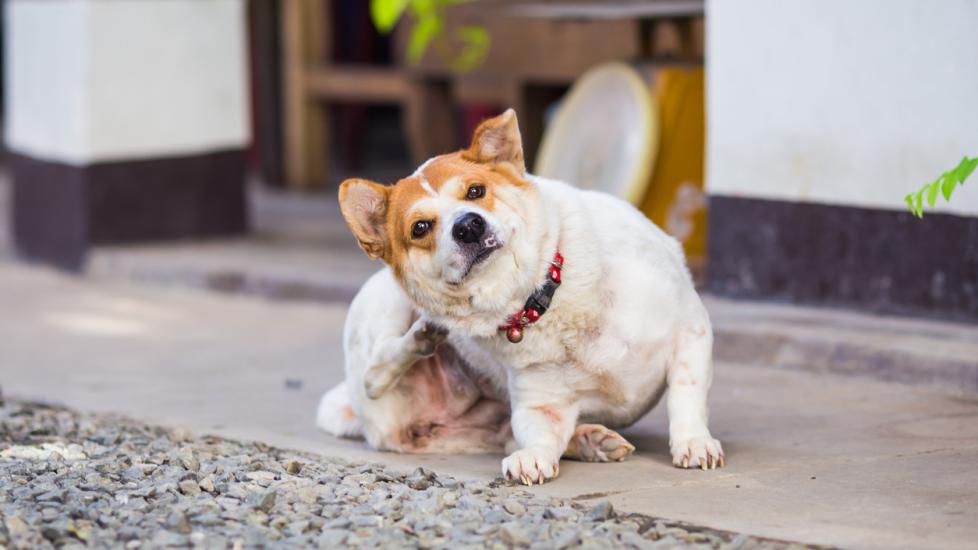Dandruff in Dogs
If you’ve noticed white flakes in your dog’s fur, you might be wondering if they have dandruff or whether dogs even get dandruff. Yes, they can. Dandruff, or seborrheic dermatitis, is common in dogs and humans alike.
Dandruff is not typically a sign of a serious condition, but you can talk with a veterinarian to find out what may be causing it. Make an appointment sooner rather than later if you see symptoms like extreme itchiness or a change in weight or behavior.
Here’s what you need to know about the types of dog dandruff, what to look for, any possible causes, and best treatment options.
Health Tools
Not sure whether to see a vet?
Types of Dandruff in Dogs
Not all dandruff in dogs looks like white flakes. It can be either dry or oily, or it may not even be true dandruff. The underlying skin may or may not be red or patchy from hair loss. Here are the most common types:
-
Seborrhea sicca (dry seborrhea): This dry dandruff may appear as white flakes with crusty skin.
-
Seborrhea oleosa (oily seborrhea): Your dog’s skin may have an oily feel and give off an odor.
-
Walking dandruff: If the dandruff seems like it’s moving, this is called Cheyletiella and is actually a type of mite.
What Causes Dog Dandruff?
Dandruff in dogs can be caused by several factors, including:
-
A vitamin deficiency (such as a lack of omega fatty acids)
-
Hormone imbalance
-
Immune-related issues
-
Genetic condition (more commonly seen in American Cocker Spaniels, West Highland White Terriers, English Springer Spaniels, and Basset Hounds)
-
Low humidity that strips the skin of moisture and dries it out
-
Health conditions, including hypothyroidism (underactive thyroid glands), autoimmune conditions (pemphigus), and diabetes mellitus
-
Cheyletiellosis, or “walking dandruff,” is caused by white mites that can be seen with the naked eye. The mites lay their eggs in the dog’s fur and cause extreme itchiness.
-
Bacterial and fungal skin infections
Diagnosing Dandruff in Dogs
To diagnose the underlying cause of dandruff, a veterinarian may:
-
Perform a physical examination
-
Ask how long the dandruff has been occurring, whether your dog has been scratching (or showing other habits that indicate discomfort), and what your dog’s diet/water intake is
-
Take skin samples (skin scraping) and material from your dog’s hair to check for mites or lice
-
Suggest allergy tests, such as a food elimination diet or an intradermal skin test, if an allergen is suspected
-
Examine skin cells and debris from your dog’s ears for yeast or bacterial infection
-
Do a tissue biopsy to test for cancer
-
Do blood tests to screen for:
-
Diabetes mellitus
-
Hypothyroidism (low levels of thyroid hormone)
-
Home Remedies and Treatments for Dog Dandruff
In simple cases, dandruff may be prevented with good nutrition and regular grooming. Some veterinarians may suggest adding omega-6 fatty acids to the diet, but always check with your veterinarian before changing your dog’s diet.
Be sure to talk with your vet for at-home remedies that fit your dog’s situation. Never use anti-dandruff products for humans; these products can be harmful to dogs.
Other treatment recommendations may include:
-
Bathing your dog regularly, using an oatmeal-based dog shampoo or soothing shampoos such as Virbac Epi-Soothe. Persistent dandruff may require a prescription shampoo to calm itchy, aggravated skin.
-
Frequent brushing is important to massage the skin and help spread a dog’s natural oils over their body. Using the right brush is also important (one with the right firmness for your dog). Depending on your dog’s coat, you may try FURminator de-shedding tools for different coat lengths, or products like de-matting brushes and shine/condition soft-bristle brushes.
-
Mites (cheyletiellosis) require extensive treatment because they can live up to 10 days on everyday objects.
-
All pets with mites should be bathed 6 to 8 times a week. A vet may prescribe rinses containing insecticide and lime sulfur, along with oral medication.
-
Bedding, kennels, and rugs can be cleaned to prevent reinfestation.
-
Dandruff in Dogs FAQs
Why does my dog have dandruff?
Dandruff can occur in dogs as a result of dry, flaky skin; as a reaction to an allergen; or as the result of a mite infestation.
Should I be worried if my dog has dandruff?
Dandruff is usually not a cause for concern unless there are other signs, such as constant scratching or symptoms that may suggest a more serious underlying condition, like diabetes or Cushing’s disease.
Featured Image: iStock.com/Natee127
